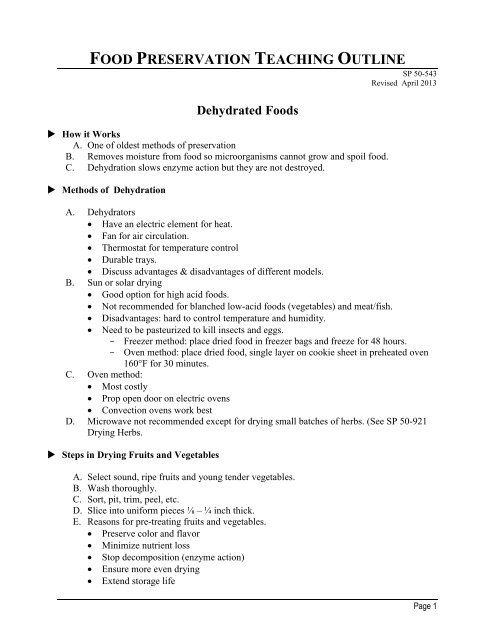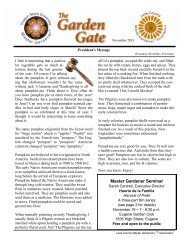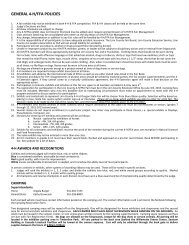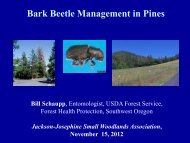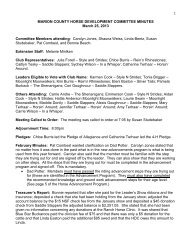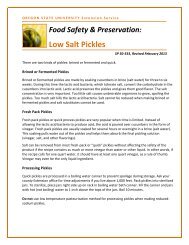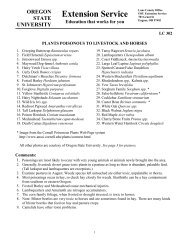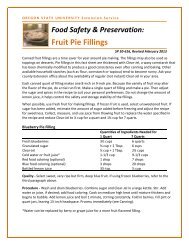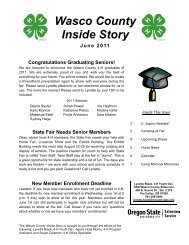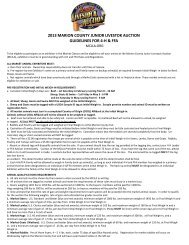food preservation teaching outline - Oregon State University ...
food preservation teaching outline - Oregon State University ...
food preservation teaching outline - Oregon State University ...
Create successful ePaper yourself
Turn your PDF publications into a flip-book with our unique Google optimized e-Paper software.
FOOD PRESERVATION TEACHING OUTLINE<br />
SP 50-543<br />
Revised April 2013<br />
Dehydrated Foods<br />
How it Works<br />
A. One of oldest methods of <strong>preservation</strong><br />
B. Removes moisture from <strong>food</strong> so microorganisms cannot grow and spoil <strong>food</strong>.<br />
C. Dehydration slows enzyme action but they are not destroyed.<br />
Methods of Dehydration<br />
A. Dehydrators<br />
Have an electric element for heat.<br />
Fan for air circulation.<br />
Thermostat for temperature control<br />
Durable trays.<br />
Discuss advantages & disadvantages of different models.<br />
B. Sun or solar drying<br />
Good option for high acid <strong>food</strong>s.<br />
Not recommended for blanched low-acid <strong>food</strong>s (vegetables) and meat/fish.<br />
Disadvantages: hard to control temperature and humidity.<br />
Need to be pasteurized to kill insects and eggs.<br />
- Freezer method: place dried <strong>food</strong> in freezer bags and freeze for 48 hours.<br />
- Oven method: place dried <strong>food</strong>, single layer on cookie sheet in preheated oven<br />
160°F for 30 minutes.<br />
C. Oven method:<br />
Most costly<br />
Prop open door on electric ovens<br />
Convection ovens work best<br />
D. Microwave not recommended except for drying small batches of herbs. (See SP 50-921<br />
Drying Herbs.<br />
Steps in Drying Fruits and Vegetables<br />
A. Select sound, ripe fruits and young tender vegetables.<br />
B. Wash thoroughly.<br />
C. Sort, pit, trim, peel, etc.<br />
D. Slice into uniform pieces ⅛ – ¼ inch thick.<br />
E. Reasons for pre-treating fruits and vegetables.<br />
Preserve color and flavor<br />
Minimize nutrient loss<br />
Stop decomposition (enzyme action)<br />
Ensure more even drying<br />
Extend storage life<br />
Page 1
Enhance destruction of harmful bacteria.<br />
F. Methods of pre-treating fruit – See PNW 397 pg. 7 for amounts<br />
Choice of method is a matter of preference.<br />
Salt/vinegar soak (2-4 Tbsp. salt and vinegar/gallon of water). Soak for 3-5 minutes.<br />
Drain well<br />
Ascorbic acid / citric acid dip<br />
Syrup/water blanching<br />
Salt solution dip<br />
Honey dip<br />
Sulfiting<br />
Sulfite caution: label <strong>food</strong>s using sulfites because some individuals are very allergic.<br />
G. Pre-treating vegetables<br />
Why?<br />
- Inactivate the enzymes causing vegetables to mature.<br />
- Prevent vegetables from becoming bitter.<br />
- Prevent off flavors.<br />
- Cleans and softens them – easier to rehydrate.<br />
Methods of blanching.<br />
- Steam blanch<br />
- Water blanch<br />
- Follow time <strong>outline</strong>d (PNW 397 pgs. 20-22)<br />
- Drain well and pat dry<br />
- Some vegetables need no pre-treatment (onions, mushrooms, zucchini squash,<br />
green peppers, hot peppers and herbs).<br />
- Canned fruits and frozen vegetables can be dehydrated without pretreatment.<br />
H. Drying Methods<br />
Dehydrator<br />
Oven<br />
Sun<br />
I. Test for Doneness<br />
Fruits—leathery and pliable because of high sugar content<br />
Vegetables—most are hard and brittle. Green peppers, sweet onions, tomatoes and<br />
mushrooms dry more like fruit.<br />
J. Storage<br />
Conditioning (PNW 397 Pg. 13)<br />
Packing<br />
- Thoroughly cool <strong>food</strong>s.<br />
- Pack into clean, dry, insect proof containers (e.g. metal cans with tight fitting<br />
lids, glass jars, moisture-vapor proof freezer containers and bags.<br />
- Need to tape edge of lid to prevent insect infestation.<br />
- Store in cool, dark, dry location.<br />
K. Problems<br />
Case hardening caused by drying at too high a temperature. A crust forms on outside<br />
of <strong>food</strong> and moisture cannot escape.<br />
Browning: can be prevented by using a pretreatment, storing in dark location. Food<br />
safe to eat.<br />
Page 2
Mold—caused by <strong>food</strong> not dried enough or not stored properly so that moisture was<br />
re-absorbed by <strong>food</strong>.<br />
Sugar crystals—often happens with overripe fruit. Safe to eat. Will dissolve if<br />
cooked.<br />
Insect infestation.<br />
L. Rehydration and using dried <strong>food</strong>s<br />
Fruits<br />
- Can be eaten as is—no rehydration needed.<br />
- Can be rehydrated by:<br />
1. Pouring boiling water or juice on fruit. Let stand 5-10 minutes.<br />
2. Steam fruit over boiling water 3-5 minutes.<br />
3. Soak in cold water for several hours.<br />
4. Cover with water and bring to boil in microwave. Let stand 5-10 minutes.<br />
5. Soaking fruit first in cold water, then cooking gives a more tender product.<br />
- Chopping fruits<br />
1. Freeze fruit first then crush with hammer or meat cleaver.<br />
2. Put frozen fruit in blender or <strong>food</strong> processor.<br />
3. Cut pieces of fruit with scissors or sharp knife. If fruit tends to stick coat<br />
blade with a little cooking oil.<br />
Vegetables<br />
- Dried vegetables will be tenderer if soaked before cooking. Can take 15 minutes<br />
to 2 hours to plump. Then cook or add to soup or stew.<br />
- Take longer to rehydrate than fruit because more water is lost.<br />
- Do not let soaking vegetables stand longer than 2 hours without refrigeration.<br />
- Vegetable flakes and powders.<br />
- Can use blender or <strong>food</strong> processor to flake or make vegetable powders – great<br />
seasonings.<br />
Food spoilage<br />
- Rehydrated dried <strong>food</strong>s should be refrigerated. Very susceptible to spoilage.<br />
Fruit and Vegetable Leather<br />
A. What is it?<br />
B. Leathers are a chewy product usually made from pureed fruits but some vegetables like<br />
tomatoes also make good leather.<br />
C. What fruits to use<br />
Fresh fruits<br />
- Any fresh fruit will work—good place to use culls, overripe fruit or those not<br />
suitable for canning or freezing.<br />
- Cut away all bruises and spoiled portions.<br />
- Citrus fruits should be used in combination with other fruits because they are so<br />
juicy.<br />
- Fresh fruit purees are usually too thin to use as is-need to be cooked to thicken<br />
or blend with drained canned fruit such as pears or apple sauce.<br />
Page 3
Canned fruits<br />
- Good way to use old canned fruits.<br />
- Easiest source of fruit for leather.<br />
- Drain off liquid and puree the canned fruits.<br />
- May add 1 Tbsp. lemon juice to puree for a fresher flavor or combined with<br />
other fruits.<br />
Frozen fruit<br />
- Thaw fruit and drain off all juice.<br />
- Puree the thawed fruit.<br />
- Combine the frozen fruit puree with drained canned fruits or bananas to thicken.<br />
D. Making the puree, tips:<br />
Puree the fruit in a blender or <strong>food</strong> processor until smooth.<br />
The puree for leather should be the thickness of apple sauce or baby <strong>food</strong>.<br />
If too thin, cook on low heat until desired thickness is achieved.<br />
For seedy fruit like berries, you might want to sieve the puree to remove some of the<br />
seeds. They become very hard.<br />
Some fruits like raspberries make very sticky leather so best to combine with another<br />
fruit like canned pears, apple sauce or bananas.<br />
E. Drying leather<br />
Line drying trays or cookie sheet with plastic wrap, parchment paper or use trays<br />
designed for fruit leathers.<br />
Spread on drying trays ¼ to ¾ inch thick.<br />
May use toppings like coconut, nut, sesame seeds or seasonings. Sprinkle on puree<br />
before drying.<br />
Dry in a dehydrator, oven or sun. Rotate tray if necessary.<br />
F. Storage<br />
After dry (should be a little tacky but no longer moist). Leather can be rolled and<br />
wrapped in plastic wrap, or cut into 4-6 inch pieces or rolls.<br />
Place rolls or pieces in heavy <strong>food</strong>-grade plastic bags or containers and store in a<br />
cool, dry, dark place.<br />
Demonstration<br />
<br />
<br />
Show how to blanch, cool and dry sliced carrots.<br />
Slice and pretreat apples or fruit of your choice.<br />
Page 4
Lab<br />
<br />
<br />
<br />
<br />
Dry fruits<br />
- Apples (using a variety of pretreatments):<br />
1. Ascorbic acid dip<br />
2. Commercial pretreatment<br />
3. Salt/vinegar dip<br />
4. Sodium bisulfate (discuss safety concerns for people with respiratory disorders)<br />
- Bananas plain and dipped in lemon juice<br />
- Canned fruit such as pineapple and apricots<br />
- Frozen or fresh blueberries (show how to crack skins). Seedless grapes can also be canned.<br />
- Parsley—using the dehydrator and the microwave.<br />
Make fruit and vegetable leathers<br />
- Canned, fresh, and frozen fruit. Have a variety of fruits available as well as toppings such as<br />
sliced almonds, coconut, and cinnamon.<br />
Make pizza leather<br />
- 15 oz can drained stewed tomatoes<br />
- 8 oz. can tomato sauce<br />
- Dried basil, oregano, and garlic powder.<br />
- Spray the drying trays or plastic wrap with a cooking spray or lightly grease with oil to<br />
prevent the leather from sticking.<br />
Reconstitute dried <strong>food</strong>s and prepare a dish such as vegetable soup, apple pie or apple-pear<br />
cookies.<br />
See SP 50-587 Enjoying Home Dried Fruits and Vegetables.<br />
Prepared by Nellie Oehler, Extension Family and Community Health, Lane County<br />
Reviewed by Carolyn Raab, Extension Foods and Nutrition Specialist<br />
© 2012 <strong>Oregon</strong> <strong>State</strong> <strong>University</strong>. <strong>Oregon</strong> <strong>State</strong> <strong>University</strong> Extension Service cooperating. <strong>Oregon</strong> <strong>State</strong> <strong>University</strong> Extension Service<br />
offers educational programs, activities, and materials without discrimination based on race, color, religion, sex, sexual orientation,<br />
national origin, age, marital status, disability, or disabled veteran or Vietnam-era veteran status. <strong>Oregon</strong> <strong>State</strong> <strong>University</strong> Extension Service<br />
is an Equal Opportunity Employer.<br />
Page 5


